My garden transformation project: why I’m digging out my lawn by hand
When it comes to transforming my garden into an edible and productive food space, there’s one task that’s taking up most of my time currently: digging out the lawn. And if there’s one question I’m answering most often from the garden updates I post it is this: why are you digging out your lawn?
Which actually has two meanings: why aren’t you keeping the lawn? and why have you chosen digging out the lawn as your method of removal?
It’s not a short answer, so I thought I’d explain it here.
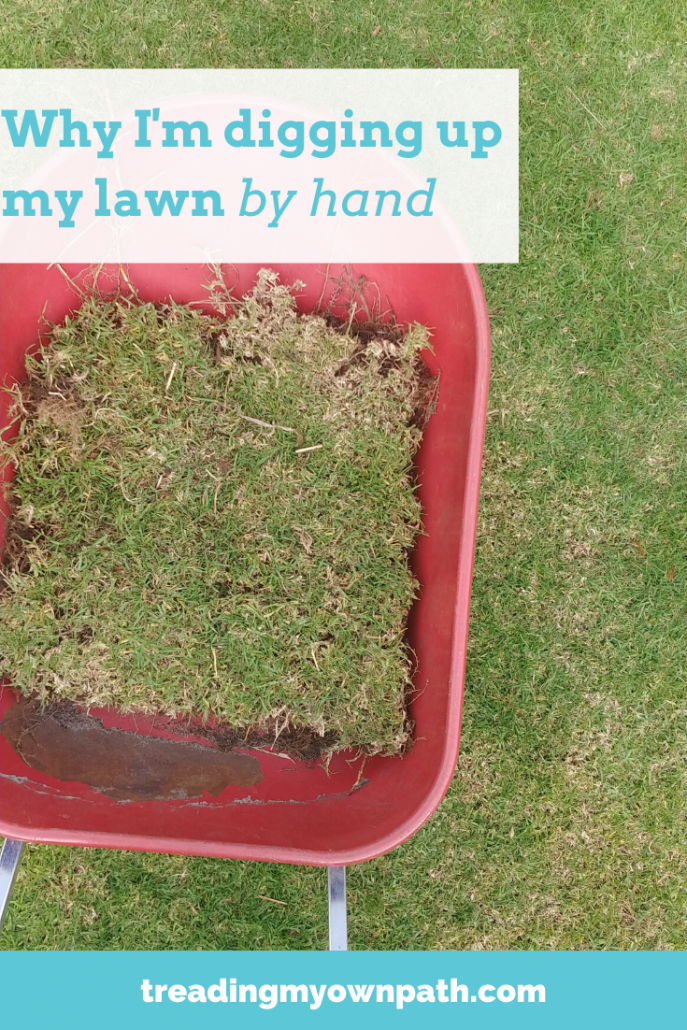
Why I’m digging out my lawn (why I’m not keeping the lawn)
I would like to grow edible food in my garden. I would like fruit trees and vegetables. I’d like native plants too. To grow these, I need to remove the lawn.

Lawn in Western Australia is not like lawn in Europe. If I leave it, it won’t grow into a beautiful field of wildflowers. In summer it will be dead without a lot of inputs. What does grow will be non-native grass species and weeds like castor oil (which is toxic to dogs – it’s the source of ricin).
My climate doesn’t naturally support meadows.
Growing lawn in Perth is hard work and takes a surprising amount of resources. It needs a lot of water to keep it green. I have a bore (which is a pump that draws water from the ground, as opposed to using drinking water from the tap) but even so, our groundwater levels are dropping and in my opinion, it is a waste of water to keep so much grass alive.
Anyways, I’m only allowed to use my bore reticulation three times a week. Any other watering needs to be drinking water.
The reticulation that’s in place to keep the lawn green is plastic and the parts break all the time. It breaks, and the trickle is replaced with a jet stream that gushes gallons of water down the road at the front (or floods the garden at the back). After replacing a few broken bits (luckily with second-hand freebies I was given, not new plastic) only to end up with more broken bits, I decided to just switch it off.
Then, it needs fertilising to keep it green. Lawn fertilisers cause a lot of problems in our rivers, because they are soluble fertilisers than run-off into the water and contribute to algal blooms (which kill the fish).
My non-fertilised lawn is yellow and patchy. Which is fine, because I’m digging it out.
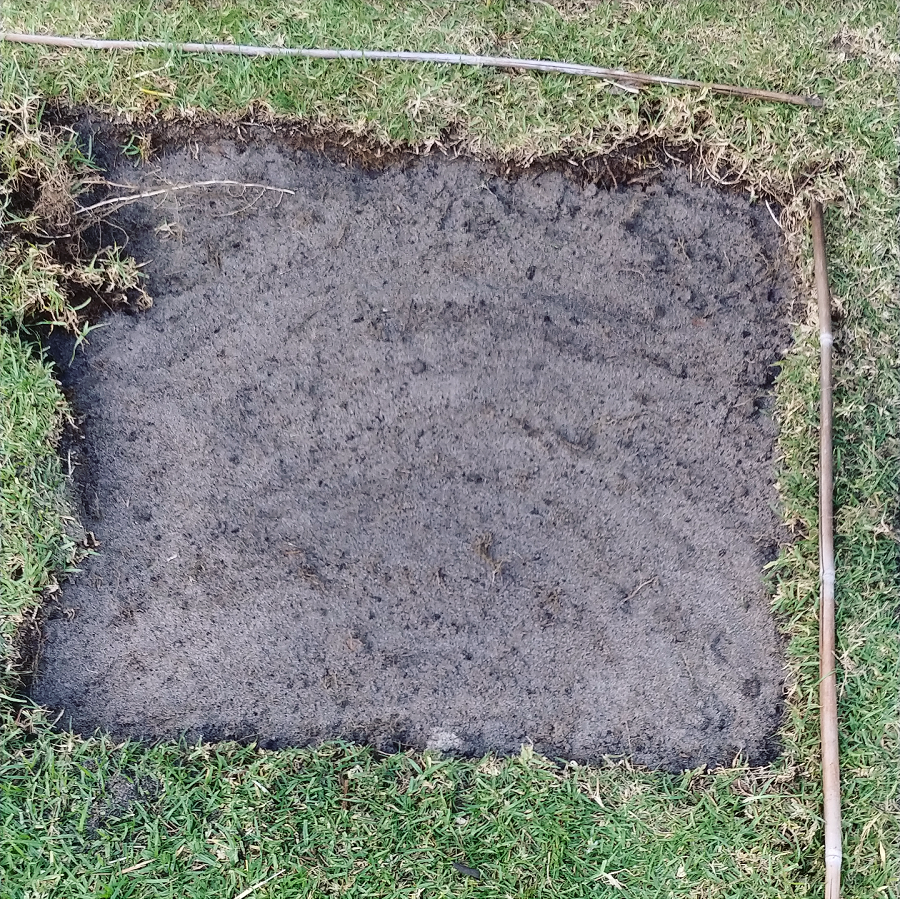
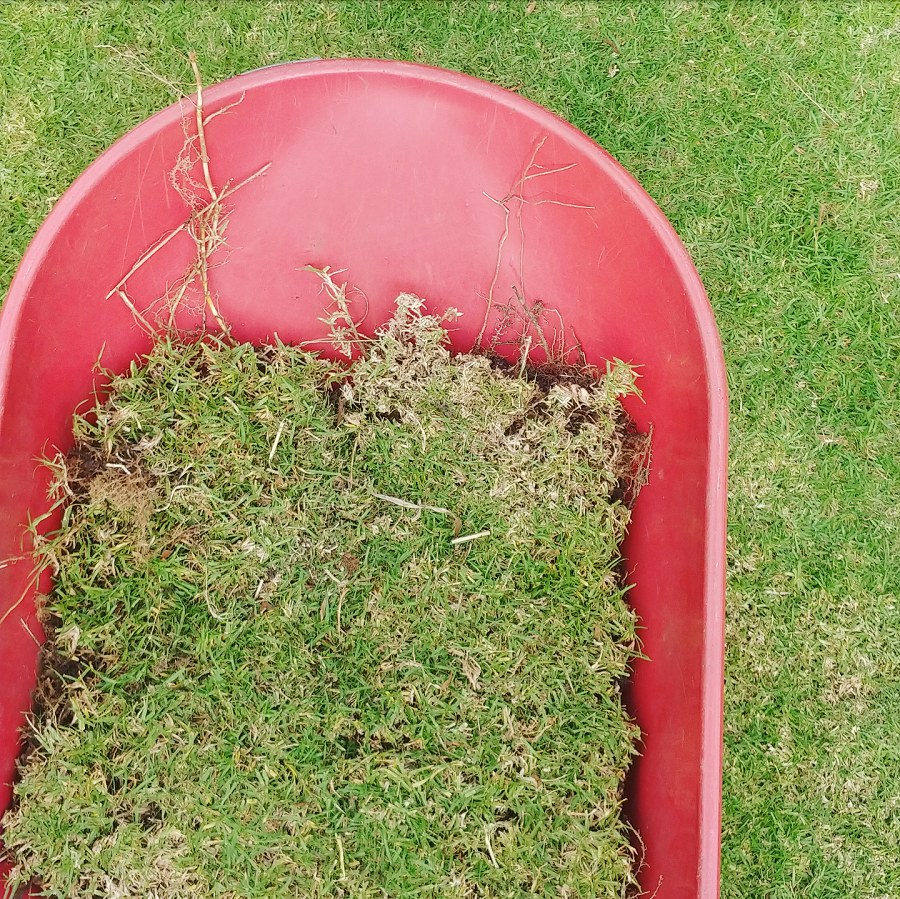
Yes, lawn feels nice underneath the feet (well, when it’s not dead). Although our Australian grasses are not as soft as the European grasses, so it isn’t quite the same. But there are parks close by with lots of grass that are properly maintained and accessible to lots of people.
I know that a lot of non-Western Australians will look at a garden full of coarse wood chip mulch and think it looks ugly and weird. It took me a bit of getting used to when I first saw it, too. But if meadows are what happens to grasses in Europe, this layer of dead tree matter is what nature does in our natural bush areas.
It acts to protect the soil from the harsh sun, retains moisture underneath – and eventually breaks down to add carbon to the soil.
Although it looks extreme now, eventually I’ll cover most of my mulch with plants so it won’t be so obvious.
Why I’ve chosen digging out the lawn as my method of removal
There are lots of ways that people choose to get rid of their lawn. Digging mine out by hand (well, I did contemplate a turf cutter, but I’ve stuck with the spade) was the only option I really considered. I know there are plenty of ways, but I have my reasons for choosing this. Let me explain them.
Perth grass is TOUGH.
Even though I told you grass dies here in summer, it doesn’t actually die. Every autumn when the rain returns the dead patch of yellow grass resurrects itself. It dies, and yet it is almost impossible to truly kill.
There are a few species of grass used for lawns in Perth, and I have a few, definitely included these two.
Kikuyu grass: a tropical grass speces Pennisetum clandestinum, native to the highland regions of East Africa. Grows rapidly and aggressively. Categorized as a noxious weed in some regions. Has underground runners and its root system can grow to 3 metres deep.

Couch grass: a drought-tolerant grass described as ‘high maintenance and invasive’. It has an extensive root system with fine roots that is difficult to remove. Can grow through concrete. Also called Wintergreen couch – I wonder if this is because it dies back in summer and returns with vengeance in winter?
I don’t want to use chemicals (which is often recommended)
Because our grasses are so hard to kill, many gardeners and organizations recommend using glyphosate (you might know it as Roundup) to kill lawn. It’s a controversial chemical that’s been banned in many European countries due to safety concerns.

Whilst verge gardens tend to be non-edibles (well, for humans only) I’m not interested in using chemicals to kill any of my lawn that will remain in the soil and enter the food chain.
Smothering/solarising doesn’t work well in Perth
Lots of readers have suggested I just cover the grass with cardboard and mulch, or use black plastic to solarise the grass and kill it. I know that these methods work well in other places with other types of grasses, but they aren’t great in Perth.
If it has worked for you, brilliant (and I’m sure it can be done). But when it doesn’t work, all that happens is you create a cosy, warm, wet environment for the grass which means it expands its root networks, and eventually busts through the mulch/plastic.
An earlier guide to verge gardens by the Water Corporation specifically advised against these methods, recognising that they rarely work.

I’ve seen many, many examples of mulching/solarising grass failing in Perth, and I can’t say I’ve ever seen an example of it working successfully on the types of grass that I have.
Putting the work in up-front
Even if I thought that mulching/solarising was a great idea, and wanted to give it a go, I’d need to wait several months for the grass to die before I could plant anything in the ground. And I don’t want to wait.
The sooner I can plant trees the better, and the sooner I can plant vegetables the better.
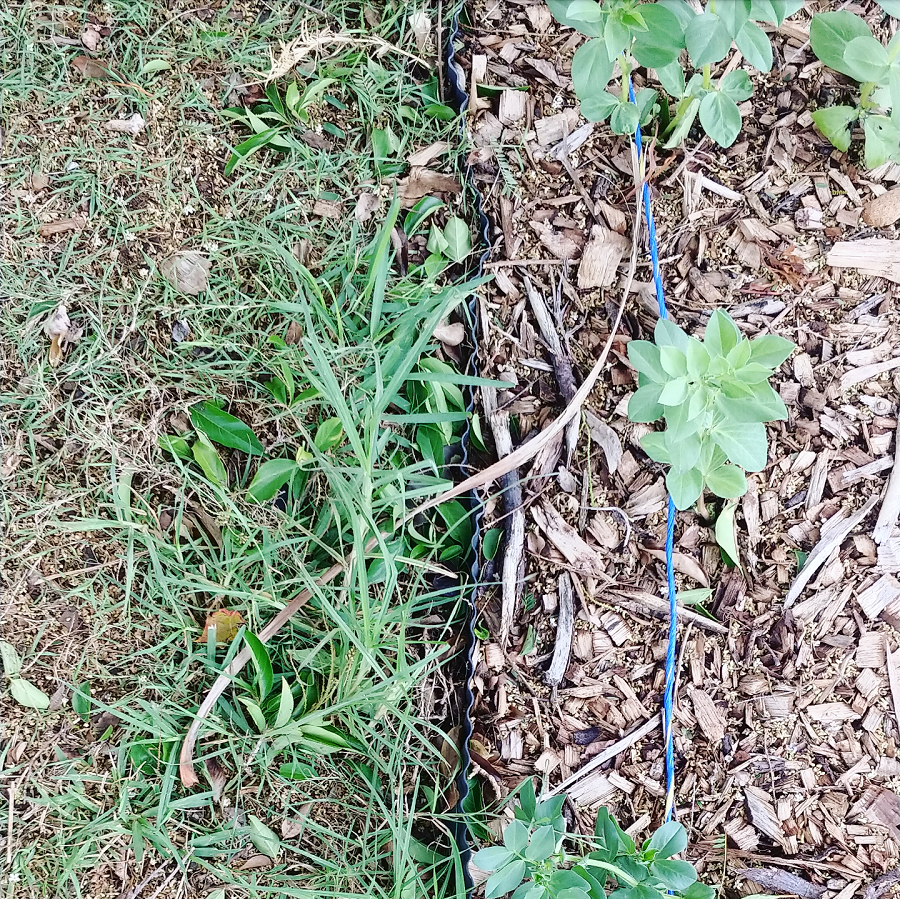
Also, I think putting in the work up-front means not playing catch-up later. I don’t want to spend the next six months digging out regrowing grass – especially not grass that has grown through raised garden beds and now has 1+ metre deep roots.
I expect there will still be some regrowth, but it should be a lot less than if I’d just tried to plant on top.
The level of the land
One other reason why sheet mulching with cardboard and then heaping on the mulch wouldn’t work for me – at the front at least – is that the ground level is already a little high. It’s higher than the driveway, which means when it rains all the water (and mulch) will run off onto the concrete and down the drain.
In a place that’s short of water, this is a huge waste. I need to ensure any water that falls stays in my soil.
Adding an extra 10-15 cm of mulch on top would create a mini mountain, and just exacerbate the problem.
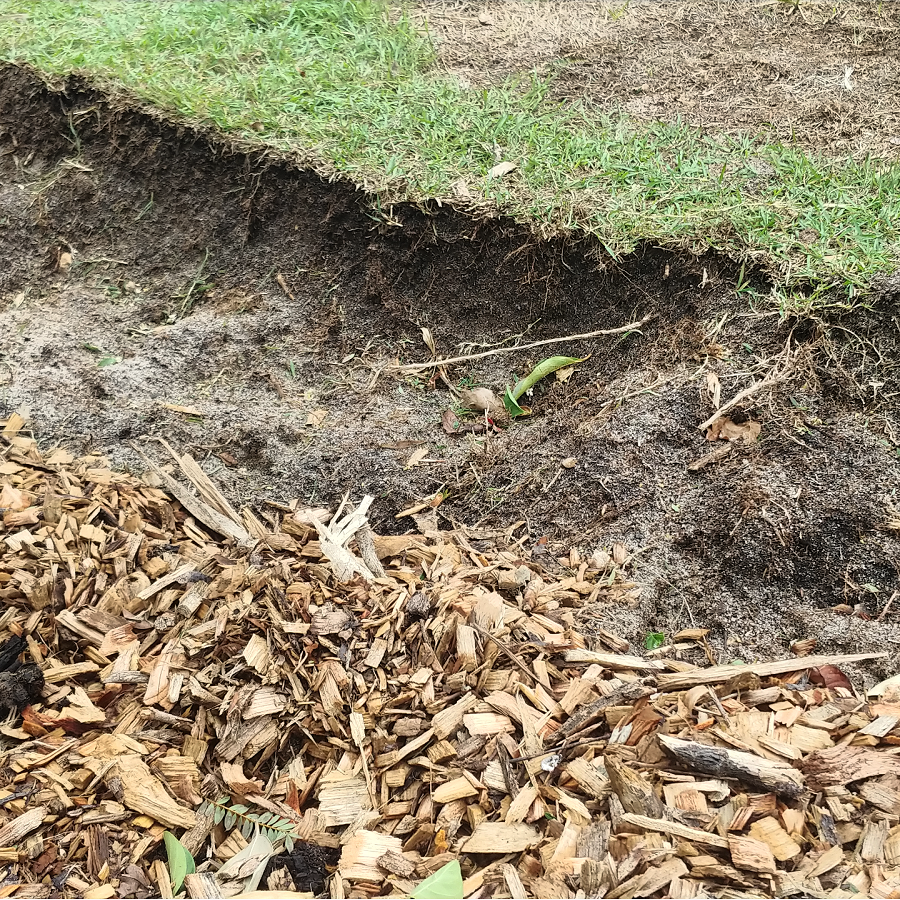
By removing the lawn I’m reducing the height of the land slightly, so the new surface is flush with the kerb/driveway.
Knowing my land
I did contemplate getting a turf cutter, and a few friends suggested just getting a bobcat in to blitz it in a couple of hours. But I decided to do it by hand.
Out the back, I don’t need it all done at once, so I’m chipping away as I’m ready to plant trees or put in beds.
At the front I am removing the whole lot, but I’ve found the by-hand approach useful.
There is a huge tree on my verge, and I don’t want to trash all of its roots with heavy machinery.
There are gas pipes, water pipes (and PVC reticulation pipes!) under the lawn, and I don’t want to damage anything.
It’s been useful to go slowly and see exactly where the roots from the big tree, my neighbours’ trees and my hedge extend, remove random bricks I find, and also see the condition of the soil (which varies from extremely bad to pretty bad. But I did find a worm. Just the one. Yeah, Perth soil is really not great).
Because I want to put in-ground beds at the front, its useful to know if there are networks of roots or blocks of concrete under the soil before I plant anything out.
Removing the lawn – progress to date
The one advantage of living on a sandpit rather than heavy clay soils is that it is fairly easy to dig out grass. It isn’t back-breaking work… but there is a lot of it.
My superstar neighbour has given me a hand out the front (I think she is impatient for it to look good!) and it is quite amazing how much can be removed in a day.
Currently, the front looks like this:
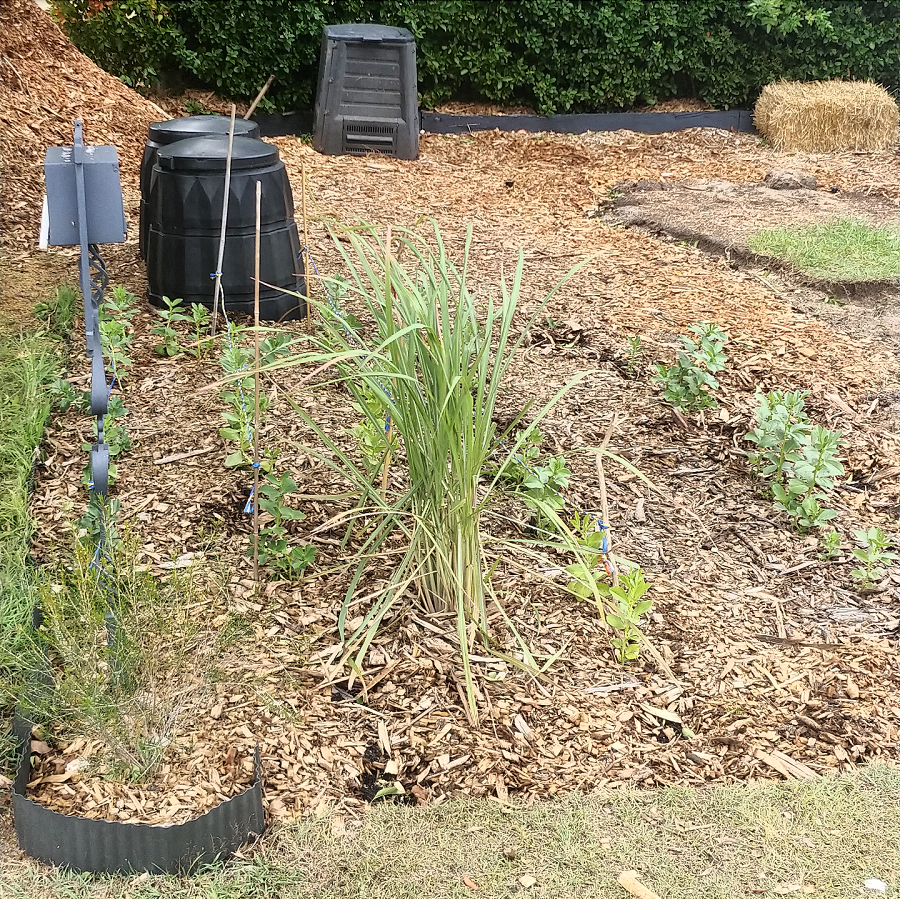
(The plants are a native Geraldton wax I transplanted from the back garden, a lemongrass bush and the beginnings of my broad bean patch).
I’m going to have another blitz at the weekend, and I’m hoping it will almost all be gone when I’m done.
Here’s the back, with the new beginnings of my citrus ‘grove’ and my raised garden beds beginning to fill up:
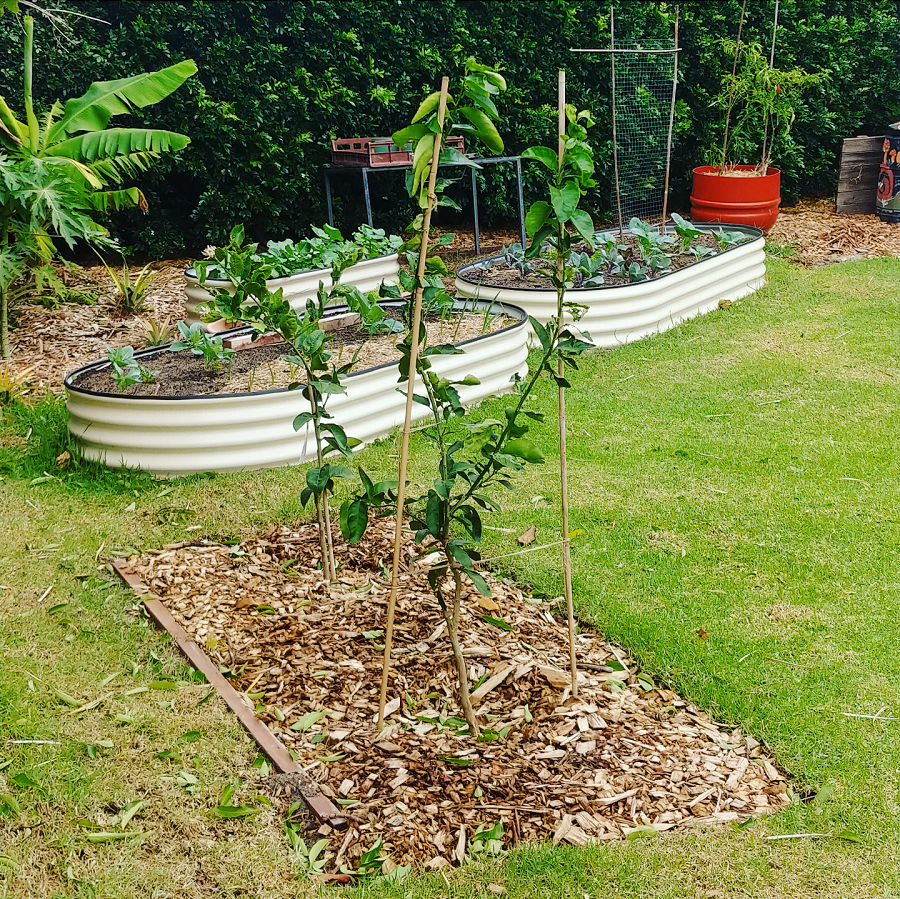
So that, my friends, is the extremely long answer to the question: why am I digging out my lawn. It’s fairly boring work up front, but the long-term rewards will be worth it.
Now I’d love to hear from you! Any more questions about lawn or lawn removal? Any experiences of removing lawn yourself – both successful and unsuccessful? Any other thoughts at all? Please share in the comments below!
[leadpages_leadbox leadbox_id=123a865e9839c5] [/leadpages_leadbox]
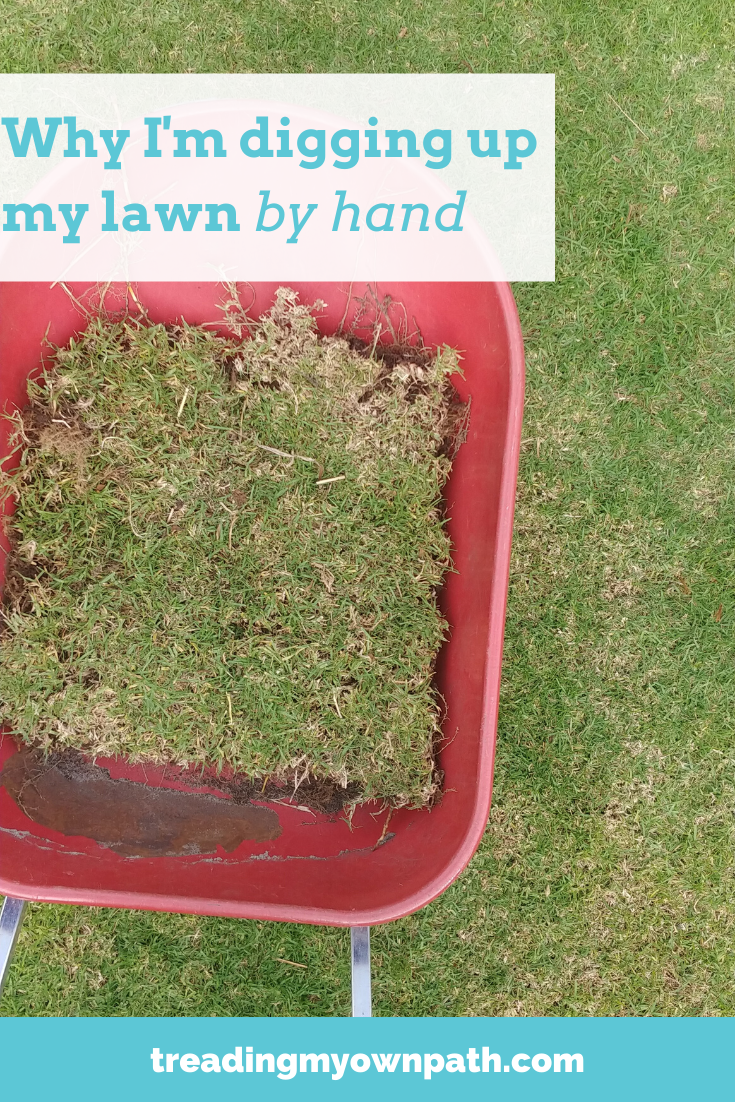

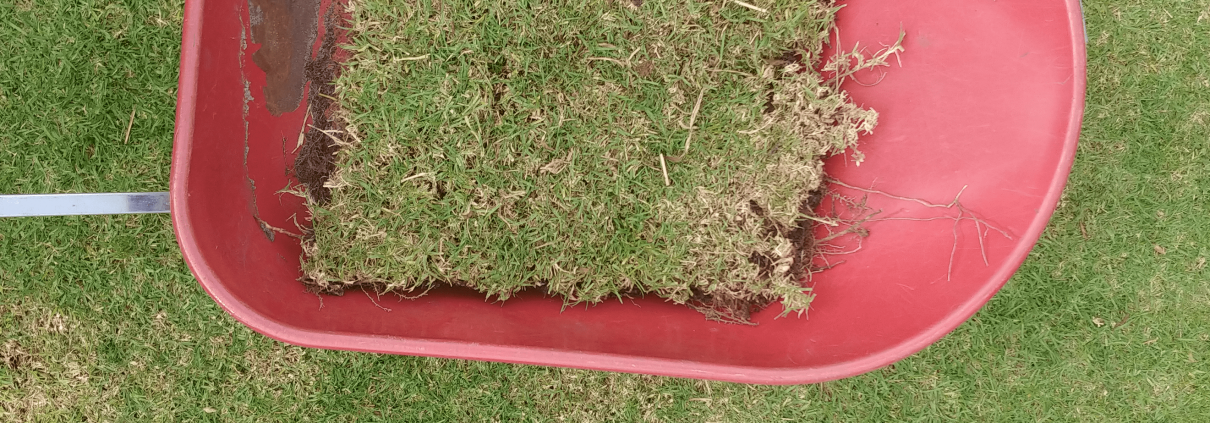




It’s totally worth digging out- and going over it to get the roots of couch and kikuyu. Very satisfying. Our front garden has been lawn free for years. Most of our weeds came from the lawn so it is now very easy to care for. I’m doing the back at the moment. Like you I’ve done bits in the past. This is the final push. A perfect lockdown pass time.
Hi Ann, yes you’re right – it is satisfying! I am prepared to be digging out some regrowth when the rains come, but I feel better knowing that I’ve tackled most of it head-on, rather than ‘waiting and seeing’. And yes, a perfect lockdown pass time :) Good luck to you and your back lawn!
Also in WA. Several years ago I decided to dig out our back lawn to plant a food forest. The repetitive knee/hip action on one side in particular has left me with intermittent but very painful hip issues. My doctor’s prescription, physio exercises (they work a treat), stop gardening (no way) and if you must you will have to sit on the ground/small stool and use your arms and one of those hand claw things to rake out all the roots to a depth of about 6 inches to a foot! This last is very therapeutic, ruins your hands/nails but gets every last skerrick of root out of the depth that you cover. Now at least 3 years on I have a sand pit of a back yard and my husband has decided he wants lawn in the middle but I can have 1.7m wide beds around it for my food plants. I also have two wicking beds in the making and a 5000 litre rain water tank that just never runs dry. Covid-19 has some advantages as I have three weeks when I should have been in NSW to get it started.
Thanks for sharing this, Catherine! Interesting that you say your 5000l tank never runs dry. I don’t have a rainwater tank here and there’s not an obvious place that it could go – there is a sunken footpath all around the house that could host it, if I’m prepared to block access… I think it would only fit 3000l though. In my old place we had a 3000l rainwater tank that was shared between 3 households, and was always empty. I’m planning to rig some barrels up to the various drainpipes. Is your rainwater tank just for the garden, or for household use as well?
I so admire your dedication and determination to make your gardens a reality. You obviously have really researched how to achieve this goal, particularly in your locale.
This garden is already serving you well, providing a positive direction to pursue during this distressing time in our lives, as well as more than enough of fresh air and exercise!
I’ve been following your blog the past half year, and have read all of your previous posts. I have been very impressed by how you continue to find ways to live an earth-enhancing life.
I look forward to following the progress of your gardens. Enjoy the process!
Thanks Ruth! I was a really keen gardener before I moved to Australia and had to give up my beloved allotment (and balcony garden) in the UK when I moved here. Even though I didn’t have many options in the first places I lived, I’ve spent that time going to community gardens and talks and workshops and learning as much as I could, so when I was ready I could go at it hard. And then in 2016 I moved to my previous place which did have the space. But now I have so much more space – and there’s no-one else making decisions except me. It’s my DREAM!
Thanks so much for taking the time to comment and your kind words. And yes, expect more garden posts from me! ;)
I too have decided to dig out a lot of my front lawn to put in fruit tree guilds. The perfect iso project. My lawn wasn’t watered during the summer as I don’t have a bore and thought it was such a waste of scheme water. I also discarded options of smothering, bobcat and chemical spraying to decide that hand digging was the best way for me. I live in the Perth hills so it was quite a hard task. Nevertheless, after all the back breaking work, I have sown a cover crop of green manure which will be dug into the soil (more digging, ugh!) in about 8 weeks. While I was impatient to get things planted, I felt it would have long term benefits to build the soil up first. I am looking forward to start planting in early spring.
This sounds great, Liz! Yes, it is the perfect project right now – it’s not like there is anywhere to go on weekends that take us away from our gardens. I’ve balanced the impatience of wanting to get things planted by holding onto the knowledge that trying to dig out couch grass AFTERWARDS is an unthankful and extremely annoying task. And I keep saying, I am going to live here forever, so I don’t need to rush to get it done right now – in a few months is fine!
Canadian here. Glad to know someone else who’s digging out their lawn by hand. Instead of sand, we are dealing with compacted clay.
We are putting in a patio in a part of our backyard that sees no sun, and in summer turns into a giant junk storage area. It is usually bare dirt, or has a moss growing fitfully over top. Due to Covid, I finally argued (and won!) that we need a place to sit outside and enjoy the summer. The pathway to the garage is already dug out, and gravel laid in, waiting for the rain to stop so we can lay the sand and pour the concrete. We will have to bring part of the lawn down several inches to match the grade of the path, but that will wait til after.
Our grass lawn has never been properly cared for, and has tons of earthworm humps. It’s not enjoyable to walk on barefoot, and I’ve been slowly incorporating more and more raised beds (square foot garden style), and planters. Having to stay home this summer instead of camping, means I’ll have time to look after everything.
Sounds like an excellent project, Sue. And an excellent use of the dumping ground! Hope the rain stops soon! (If it hasn’t already)
That is what we are doing now :) Thanks for the post!
Hurrah, and thanks for taking the time to comment Maria :)
I’m also in Perth. Have dug some buffalo out by hand and then power planter for veggie patch. Took me 2 months hard work but power planter 24 inch drill cut the time markedly. Our lawn is raised with thick buffalo. Would love to plant fruit trees too. My husband dug out a large rectangle in the front for 3 standard roses so cut down lawn area a bit.
Sounds like you are making excellent progress, Liz! :)
I’m so glad you have used the just-dig -it-right-out method! I live in Sydney and have seen so many well-meaning examples of chemical-free lawn removal go a bit astray: couch, kikuyu, buffalo and other tough grasses reinvading after carefully wetted layers of newspaper piled on top of lawns gradually broke down. And some instances of flattened cardboard boxes – without the sticky tape etc removed (plastic in the soil: yuck) or of newspapers/ magazines with coloured inks being used – I’m sure at least some of those inks are not nice for soils. I’m in a townhouse and didn’t have too much lawn to dig up but the downside is I do have the challenge of a lot of shade. Probably a good thing: otherwise I’d be stymied by too much choice of what to grow! Currently harvesting loads of green leafy veg, herbs; my lemon trees are finally producing… best of luck with finishing your project and may I please suggest working bees. Excellent fun and sometimes you seem to get so much more done: e.g. if there are five of you, you get more done than one person times five, if you see what I mean. I’ve been on many fabulous Permaculture group ‘bees.
Here we get to know about digging out lawn information in detail. It helps us to decide that which one is best among its types. I enjoyed reading this article and would suggest others it as well. Thank you for this article! This is really very informative for us.
This is a very informative blog, thanks for sharing about the digging out lawn. It will help a lot, these types of content should get appreciated. I will bookmark your site; I hope to read more such informative contents in future.
Thanks for this post! I am trying to decide how to go about removing our lawn. What are you doing with what you dig out? And, are you taking a certain amount of dirt, too? I’ve read that you should take out at least 4” to keep it from growing back.
Thanks so much for this post. I found it really helpful as I’m doing the same to my lawn and have come to the same conclusions as you so am doing it by hand. Do you have an update on how it went? Kikuyu is notorious and people have told me without using Roundup I’m wasting my time… I’m happy to weed a little, though.
Surprised to see this, honestly, as this price was something not expected. Such efforts can be made by them only as they have been doing this recently. I hope it is now people will be digging out their lawns and starting gardening.
I like your excavation tips. I need a hole dug. I’ll have to consider getting a contractor.
Thanks for the inspiration- just needed a reminder of why I am digging out the lawn in Perth!